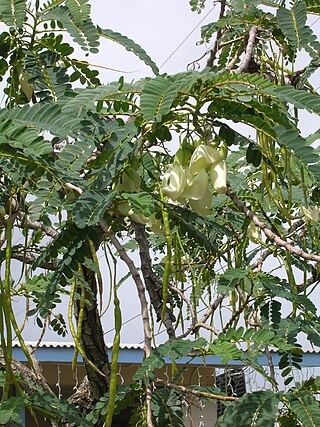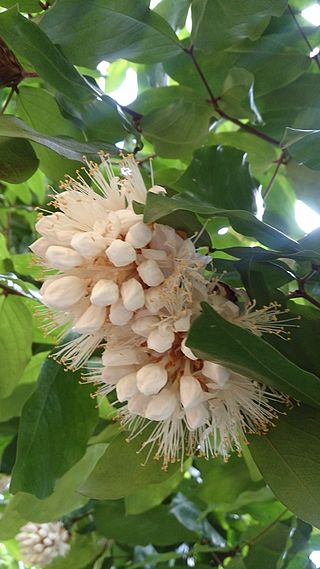
Magnolia grandiflora, commonly known as the southern magnolia or bull bay, is a tree of the family Magnoliaceae native to the Southeastern United States, from Virginia to central Florida, and west to East Texas. Reaching 27.5 m (90 ft) in height, it is a large, striking evergreen tree, with large, dark-green leaves up to 20 cm long and 12 cm wide, and large, white, fragrant flowers up to 30 cm (12 in) in diameter.

Sesbania grandiflora, commonly known as vegetable hummingbird, katurai, agati, or West Indian pea, is a small leguminous tree native to Maritime Southeast Asia and Northern Australia. It has edible flowers and leaves commonly eaten in Southeast Asia and South Asia.

Portulaca grandiflora is a succulent flowering plant in the purslane family Portulacaceae, native to southern Brazil, Argentina, and Uruguay and often cultivated in gardens. It has many common names, including rose moss, eleven o'clock, Mexican rose, moss rose, sun rose, rock rose, and moss-rose purslane. Despite these names and the superficial resemblance of some cultivars' flowers to roses, it is not a true rose, nor even a part of the rose family or rosid group; rather, it is much more closely related to carnations and cacti.

Cynometra is genus of tropical forest trees with a pantropical distribution.

Cynometra cauliflora is a small, cauliflorous tree with a thick, heavily branched stem, and rather small flowers, about 1.2 cm (0.5 in) across, that appear on the stem in clusters. It is known in Indonesian as namu-namu, after the flattened, crescent shaped pods, which look similar to the Indonesian pastry, namu-namu. In the city of Ternate, it is called namo-namo, and ñam-ñam in the Maldives. It is a species of the genus Cynometra, native to Malaysia, and found mainly in northern peninsular Malaysia.
Cynometra filifera is a species of plant in the family Fabaceae. It is found only in Tanzania.
Cynometra gillmanii is a species of plant in the family Fabaceae. It is found only in Tanzania. It is threatened by habitat loss.
Cynometra longipedicellata is a species of plant in the family Fabaceae. It is found only in Tanzania.
Cynometra lukei is a species of plant in the family Fabaceae. It is found in Kenya and Tanzania and threatened by habitat loss.
Cynometra suaheliensis is a species of plant in the family Fabaceae. It is found in Kenya and Tanzania.
Cynometra ulugurensis is a species of plant in the family Fabaceae. It is found only in Tanzania.
Cynometra vitiensis is a species of plant in the family Fabaceae. It is a tree found only in Fiji.
Cynometra minor is a species of plant in the family Fabaceae. It is a tree found only in Fiji.
Cynometra vestita is a species of plant in the family Fabaceae. It is a tree found only in Fiji, on the islands of Viti Levu and Vanua Levu.
Zenkerella is a genus of plants in the family Fabaceae.

Cynometra lenticellata is a flowering tropical tree in the family Fabaceae. It is native to tropical semi-deciduous rainforest and gallery forests in northern Queensland, some of the Torres Strait Islands, and New Guinea. Common names include: silk handkerchief tree, cascading bean, and native handkerchief tree.
Cynometra rosea is a species of flowering plants in the family Fabaceae. It is a tree endemic to New Guinea. It belongs to the subfamily Detarioideae.
The Bugoma Forest is a protected tropical forest that is situated southwest of Hoima and northeast of Kyenjojo towns, and east of Lake Albert, in the Hoima district of western Uganda. It was gazetted in the 1932 and came under the mandate of the National Forestry Authority in 2003. But it was expanded in 1965, 1968 and 1998. Its surface area is given as between 41,144 hectares (411.44 km2) and 65,000 hectares (650 km2).

A tree in the family Fabaceae, Cynometra ramiflora is found in mangroves and flooded forests from New Caledonia in the western Pacific west to Queensland in Australia, New Guinea, Island Southeast Asia, and Tropical Asia as far west as India. Its wood is used for construction and fuel, and parts of plant are ascribed medicinal use.

Cynometra browneoides is a flowering plant in the pea family (Fabaceae). Common names includes handkerchief tree and pokok sapu tangan. It is a tree native to New Guinea. It has been introduced to Java and Sumatra.






